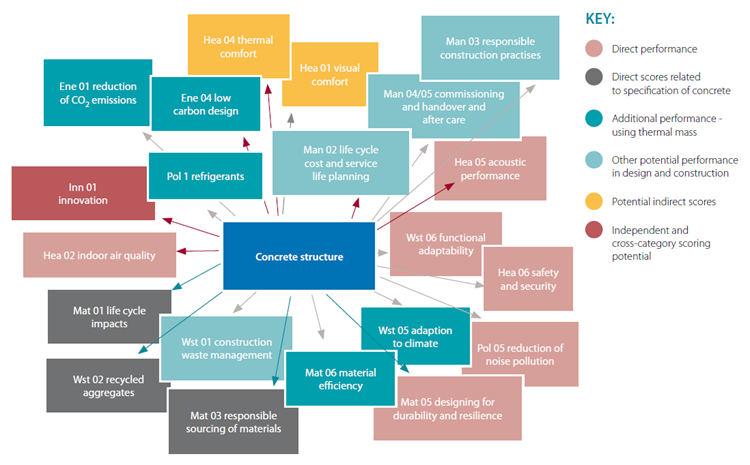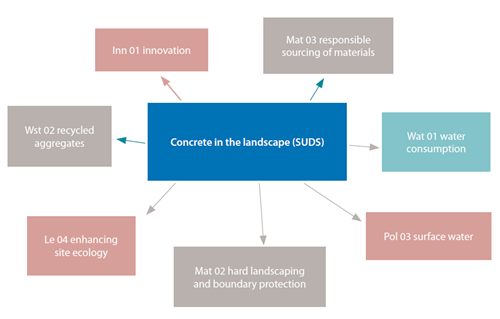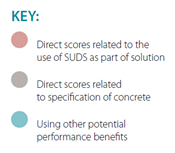BREEAM
BREEAM is a suite of assessment methods developed by BRE Global Ltd. that provide a benchmark for sustainable construction and design. Schemes exist for assessment of most building types or forms of development including BREEAM in-use, BREEAM communities, BREEAM Infrastructure. In May 2014 BREEAM New Construction (BREEAM NC 2014) replaced the existing 2011 version for the assessment of new construction for non-domestic buildings.
Download The Concrete Centre guide: Concrete and BREEAM.
Each of the BREEAM schemes assesses performance across a range of similar sustainability issues.
In BREEAM NC 2014 the categories are:
- Management: Improved planning, project management cost analysis and construction processes
- Health and well-being: Increased comfort and safety in use (visual, thermal, acoustic, security, indoor air quality)
- Energy: Improved energy efficiency and reduced carbon emissions of building in use
- Transport: Improved access to sustainable transport for building use
- Water: Reduced water consumption in use once occupied
- Materials: Reduced impact of construction materials, with LCA, Responsible Sourcing, resilience and material efficiency
- Waste: Reduced waste production on site, in use and in the future and reward use of recycled aggregates
- Land Use & Ecology: Reduced ecological damage and enhanced ecology on site
- Pollution: Reduction in NOx emissions, night-time and noise pollution and surface water run-off
- Innovation: Exemplary performance and innovation
Concrete and BREEAM
Concrete is a cost-effective, plentiful and readily available, locally sourced material in the UK, with established supply chains and construction techniques. It has been used effectively in many award-winning buildings that have achieved the highest BREEAM ratings. View case studies.
Concrete’s versatility offers construction solutions that provide opportunities to score credits either directly or indirectly in nearly all of the categories.
Many issues in BREEAM are linked and early strategic design decisions can facilitate scoring points. One effective route is to use the thermal mass of the exposed concrete structure, often concrete soffits, as part of an energy efficiency heating and cooling strategy.
A low energy servicing strategy using natural ventilation can score specific points in Energy, Health and Well-being and Pollution categories and also potentially Waste, and Materials through the issues Adaption to Climate Change, and Material Efficiency. If this strategy uses the thermal mass of concrete with night time cooling, other inherent performance benefits such as acoustic insulation, fire insulation, durability, low maintenance and VOC- free finishes offer opportunities for potential additional scores elsewhere.
Figure 4: Connected credits - potential areas for credits related to choice of creative structure

Note: Extract from Concrete and BREEAM (page 9, Figure 4)
A Sustainable Urban Drainage system (SUDS) has the potential to score points in the water, Pollution, Land use and Ecology categories and is assessed for further points in Materials and Waste. There are many SuD systems using concrete products.
Figure 5: Connected credits - potential areas for credits related to choice of concrete SUDS.


Note: Extract from Concrete and BREEAM (page 9, Figure 5)
Scoring credits in BREEAM with concrete
A summary of some of the key issues for concrete are below.
For more detailed guidance how concrete can score in BREEAM refer to The Concrete Centre guidance Concrete and BREEAM.
Energy efficiency
Maximising the credits in the Energy section is fundamental to achieving a high BREEAM rating. The high thermal mass of concrete means that it is well placed to assist with the reduction of energy consumption and lower carbon emissions in use – both key components of this category. Thermal Mass Explained and Concrete Floors for Passive and Active Cooling provide guidance on the use of thermal mass in buildings.
One option is through the use of exposed concrete soffits as part of a building’s heating and cooling strategy. This approach works the material hard, as it must not only fulfil the design’s structural requirements, but must also satisfy its thermal and aesthetic needs. The resulting savings in operational energy through exploiting the floor’s thermal mass are often significant, particularly in environments with a high cooling load. A further benefit is the ability to design out the need for suspended ceilings, avoiding their embodied impacts and requirement for periodic replacement.
Health and well being
The use of concrete walls, floors and roofs offer opportunities to score points in various parts of this section, using both concrete’s thermal mass as part of a natural ventilation strategy for thermal comfort, but also directly through other performance benefits including inherent good acoustic insulation. Concrete is naturally inert and VOC and formaldehyde free. Unlike other structural solutions it can meet, and often exceed, acoustic and fire requirements with recourse to other treatments or finishes that may contain VOCs or formaldehyde.
Management
Concrete is a durable, low maintenance construction solution offering cost effective whole life benefits which can benefit life cycle cost and service life planning. Concrete offers construction solutions that support responsible construction practice. Most concrete production is responsibly sourced (BES 6001) and production sites certified to the EMS standard ISO14001. Some concrete construction solutions can help score credits by providing design and commissioning resources.
Materials
This credit provides many opportunities to score credits using concrete both a part of the fabric of the building and in the hard landscaping in the materials section:
Waste
- Construction waste management: There are many ways in which concrete can be used and specified to reduce waste on site. These include low waste construction solutions including precast off site manufacture, hybrid and cast insitu concrete such as post-tensioning. Concrete is 100% recyclable, and typically regarded as a non-hazardous waste material during deconstruction and demolition. The concrete industry continues to develop guidance for contractor and designers to assist with the reduction of waste on site including those within the Resource Efficiency Action plans (REAPS) initiatives.
- Recycled Aggregates: This credit can be achieved using recycled or secondary aggregates, the feasibility of which will be determined in part by availability of suitable local supply. More guidance on the technical issues related to use of recycled aggregates can be found in the Specifying Sustainable Concrete documents.
- Adaptation to climate change is a new issue introduced into BREEAM 2014. Concrete is inherently resilient and offers a cost effective response to structural and other building fabric design for climate change adaption helping to score, this and its associated exemplary credit. Concrete is robust enough to withstand high winds and its structural integrity is unaffected by flooding, driving rain or other exposure to water. Concrete is resilient to fire, with no spread of flame and is unaffected by solar radiation. Its thermal mass can be a significant role in reducing the risk of future overheating when used with adequate ventilation.
Functional adaptability
Concrete can provide an effective structural solution to accommodate future adaptation, designed for long life and an appropriate range of uses. Structural floors and flat soffits facilitate fixings for internal walls and services without limiting their location. The frame is robust and fire proof so any finishes can be stripped back without compromising structural or fire integrity.